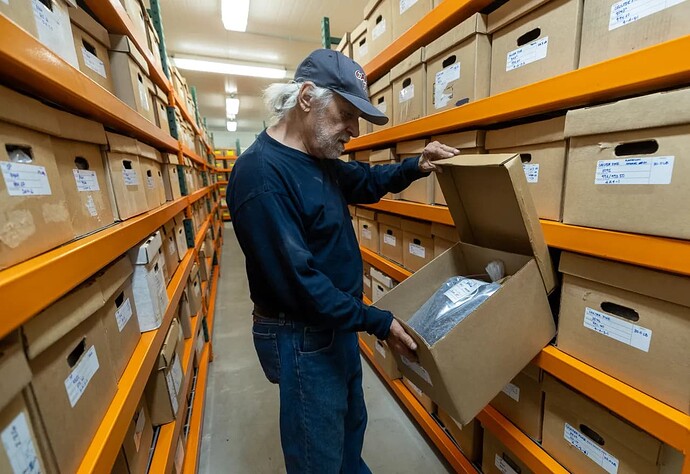DAVIS — A frozen forest, preserved as tiny seeds packed in tall stacks of labeled boxes, holds the future of California‘s scorched woodlands.
With wildfires consuming trees at an alarming rate, the role of the sub-zero repository at the California Department of Forestry and Fire Protection’s Reforestation Center is taking on new urgency.
It stores over 42,000 pounds of pristine seed collected from the state’s native conifers, from coastal redwoods to alpine firs. An adjacent facility holds young oaks and other hardwood species. The center’s goal is to help private landowners restore their charred landscapes — rebuilding forests too badly burned to regrow naturally.
Bill Nickles peeks into a box of conifer seeds stored in the zero-degree cooler at Cal Fire’s Reforestation Center in Davis, Calif., Tuesday, Sept. 3, 2024. (Karl Mondon/Bay Area News Group)
But much more is needed. After decades of forest mismanagement that created an era of megafires, there’s a critical shortage in quality seed stock, trained personnel, storage and growing space for tiny seedlings.
“The demand far exceeds the supply,” said Cal Fire forester James Scheid, who manages the center’s Reforestation Services Program. Three-quarters of requests to the center go unfilled.
A recent analysis found that 4 million acres of public and private lands in the Sierra Nevada, North Coast and Cascade Mountains burned from 2018 to 2021 — and, of that, 1.5 million acres, or 37 percent, were scorched by ultra-hot flames. That tally by consultants Mason Bruce & Girard does not include this summer’s massive Park Fire in Butte and Tehama counties, which claimed another 430,000 acres.
Dead trees don’t produce seeds, and the high-heat burn patches are too large and far away from live seed sources.
Seeds extracted from Douglas fir trees are bottled at Cal Fire’s Reforestation Center laboratory in Davis, Calif. (Karl Mondon/Bay Area News Group)
Unable to naturally regenerate, the 1.5 million acres of burned forests will stay ghostly for years. They’re dangerous for hikers and campers. Over time, there’s erosion, and invasive brush moves in.
“There’s a moral imperative for human involvement at this point,” because decades of fire suppression have created overcrowded forests that burn quickly and intensely, said Leana Weissberg of the conservation nonprofit American Forests.
Decades ago, before environmental regulations reduced logging in forests and the timber industry collapsed, there was a bustling business of nurseries.
At its height, the U.S. Forest Service had 13 tree nurseries in the nation; today, only six remain, including one in Placerville.
The state of California once supported three tree nurseries — in Ben Lomond, Magalia and Davis — which produced about 6 million trees per year for landowners all over the state. Now two of these nurseries are gone, casualties of a long-ago state budget crisis.
Kuldeep Singh, operations manager at Cal Fire’s Reforestation Center, checks on the health of six-month old coast redwood starts growing at the facility’s nursery in Davis, Calif. (Karl Mondon/Bay Area News Group)
The Davis-based reforestation center, adjacent to Interstate 80, remains. But it can grow only 250,000 seedlings a year. To replant just 25 percent of California’s private forestlands, it needs to expand its capacity 300 percent.
Its trees are restoring replanting landscapes damaged by some of the state’s largest and consequential fires: Valley, in 2015; Camp, 2018; CZU Complex, 2020; August Complex, 2020; Glass, 2020; Creek, 2020; Caldor, 2021, Lava, 2021 and Mosquito, in 2022, among others.
To meet growing demand, the center is in the early stages of a multiyear upgrade — expanding its Seed Bank, building new greenhouses and buying state-of-the-art processing equipment.
Meanwhile, American Forests is collaborating with the state and federal government in the Reforestation Pipeline Partnership to boost seed collection, processing, storage, nursery production and planting.
This year’s collecting season is off to a robust start. Conifers reproduce intermittently — and this seems to be a banner year for Ponderosa pine, sugar pine and Jefferey pine. Across the state, foresters are peering through binoculars to survey the tips of branches, heavy with cones.
Bill Nickles walks past containers filled with Ponderosa pine cones, Tuesday, Sept. 3, 2024, at Cal Fire’s Reforestation Center in Davis, Calif. The cones are being prepared to have their seeds extracted.
Already, 2,000 bushel bags of cones have been collected by Cal Fire foresters. By comparison, last year was lean, yielding only 210 bushels. In just two days this week, American Forests collected 157 bushels in El Dorado National Forest, near Placerville.
At least 75,000 bushels are needed to fully restore California’s burned acres, Weissberg said.
“Whenever there are good years, we want to capitalize on that,” she said.
Collectors don’t take just any cone: only the best of the best will do.
At each site, they inspect a sample. If cones are curved, like a banana, that indicates insect infestation. If they’re too green, the hardened case won’t open. If they’re too old, seeds have already scattered over the forest floor.
Some cones are sent back to Davis to be X-rayed. Inside each cone are dozens of seeds, and scientists search for healthy embryos.
If judged acceptable, there’s a brief window — only several weeks — to retrieve the cones at peak maturity.
Climbers reach into trees’ canopies to pluck the cones, which are loaded into bushels, each labeled by name and “seed zone” location. The bushels are trucked to facilities and laid out in sheds to dry.
October starts the processing and seed extraction season. A kiln, a giant chute that blows hot air, bake the cones to accelerate drying. Each species has its own precise needs. For example, Sugar pines are heated at 95 degrees; Ponderosa pine at 90 degrees; and Douglas fir at 85 degrees. Sequoias and cedars need no heat at all.
Source: To build back burned forests, California needs many more seeds



